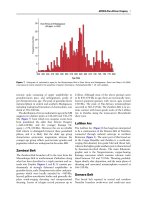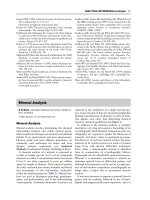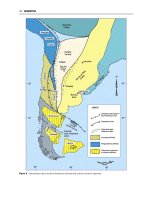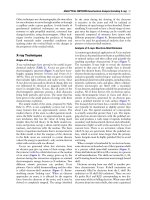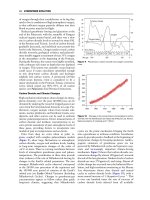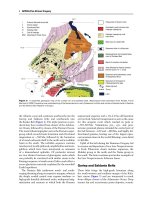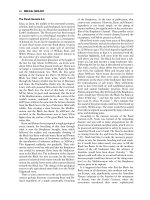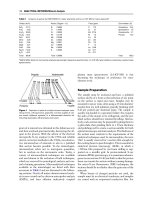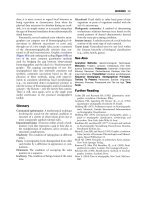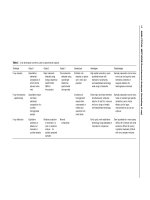Encyclopedia of geology, five volume set, volume 1 5 (encyclopedia of geology series) ( PDFDrive ) 765
Bạn đang xem bản rút gọn của tài liệu. Xem và tải ngay bản đầy đủ của tài liệu tại đây (51.53 KB, 1 trang )
EUROPE/The Alps 129
Further out towards the foreland, shelf sediments of
the European margin were detached from their substrate, shortened by folding and thrusting, and transported towards the west. They now form the Jura
Mountains. In addition to all of the thrusts and
folds that represent WNW–ESE shortening, there
were substantial movements in and out of the plane
of the section shown in Figure 4A. These movements
were related to strike–slip motions that displaced the
Adriatic margin towards the north relative to the
European margin.
Central Alps
Investigation of the Central Alps by the Swiss National Research Project (NRP) 20 has provided results
complementary to those of the European GeoTraverse (EGT). The EGT study assessed the continental
lithosphere that runs from the North Cape across
Europe to Tunisia. Several transects were profiled
across and within the Swiss Alps. Figure 4B, a profile
along the central traverse of NRP 20, has been
extended to include the Jura Mountains and the Po
basin. As with the Western Alps, the asymmetric structure of the Central Alps evolved during convergence
between Eurasia and Africa. The lower crust of the
European margin extends at constant thickness beneath the Adriatic lower crustal wedge. The tip of the
latter is exposed at the surface. The centre of the orogen
consists of European margin upper crustal rocks that
were stacked by thrust faults during plate convergence
and collision. The associated heat and pressure transformed the rocks: granites became orthogneisses, sediments became paragneisses, and limestones became
marbles. The mineral assemblages ‘‘frozen’’ in these
metamorphic rocks allow determination of the temperature and pressure paths these rocks took during
collision and the ensuing denudation.
Along one major fault, the Insubric Line, the nappe
stack was moved upward and southward, but erosion
kept pace with this uplift and removed a large section
of the Austroalpine and Penninic nappes. Studies of
the rocks outcropping at the surface indicate that they
were once buried to depths exceeding 25 km. Strike–
slip motion along the Insubric Line moved the Adriatic margin westward relative to the European
margin in the later stages of the collision. In the
north-western part of the orogen, the thrusting was
chiefly towards the north-west. Conversely, thrusting
was directed towards the south-east in the southeastern part of the orogen. In both cases, the sequence
of thrusting was from the centre of the orogen towards the forelands. This can be interpreted as
the result of the collision of the European and Adriatic continental margins. Deformation of the crust
occurred within the zone of contact and the deformed
rocks were shoved on top of each other to form an
orogenic wedge, similar to the wedge of snow
forming in front of a moving snowplough. Shortening related to plate convergence and collision is
particularly accentuated along this transect of the
Alps. The associated uplift and erosion are indicated
by the high degree of metamorphism of the exposed
rocks outcropping at the surface. The focused horizontal shortening (and vertical stretching) explain
why the Alpine chain is particularly narrow in this
transect.
Eastern Alps
The Eastern Alps have been studied in a joint project
(TRANSALP) between Germany, Austria, and Italy.
A seismic transect through the Eastern Alps and the
Dolomites has produced the seismic data and geological interpretations shown in Figure 4C. The
crustal structure of the Eastern Alps is rather different
from that of the western and central sections. The
European margin shows a thin slab of lower crust
dipping to the south. The Adriatic lower crust is
thicker and has a piece protruding into the European
upper crust. The upper crust of the European margin
forms a large-scale basement uplift that is exposed in
the Tauern window. The Helvetic nappes are virtually
absent in this transect and the Penninic nappes make
up only a proportionally small volume . The upper
crust of the Adriatic margin, on the other hand, is
much more voluminous. It is over 30 km thick and is
shortened by thrust faults. Important strike–slip
motions have displaced the Adriatic margin to the
west, relative to the European margin along the
Pustertal line.
Alpine Nappe Structures
Collision between the two margins of the Eurasian
and African plates, like the crash of two cars, led to
severe deformation (folding and fracturing) of the
rocks within the zone of contact. Large-scale fractures in a zone of compression led to the formation
of thrust faults that transported entire crustal blocks
upward on a gently inclined fault surface. The displaced blocks were typically several hundreds of
kilometres wide, 50–100 km long, and only a few
kilometres thick. These thrust sheets are termed
‘nappes’, from the French for ‘tablecloth’, because
of their shape. The (horizontal) shortening of the
continental crust also led to the folding of layers of
rock. The folds, which occur on every scale, from
millimetres to kilometres, are an expression of the
penetrative deformation of crustal rocks.
